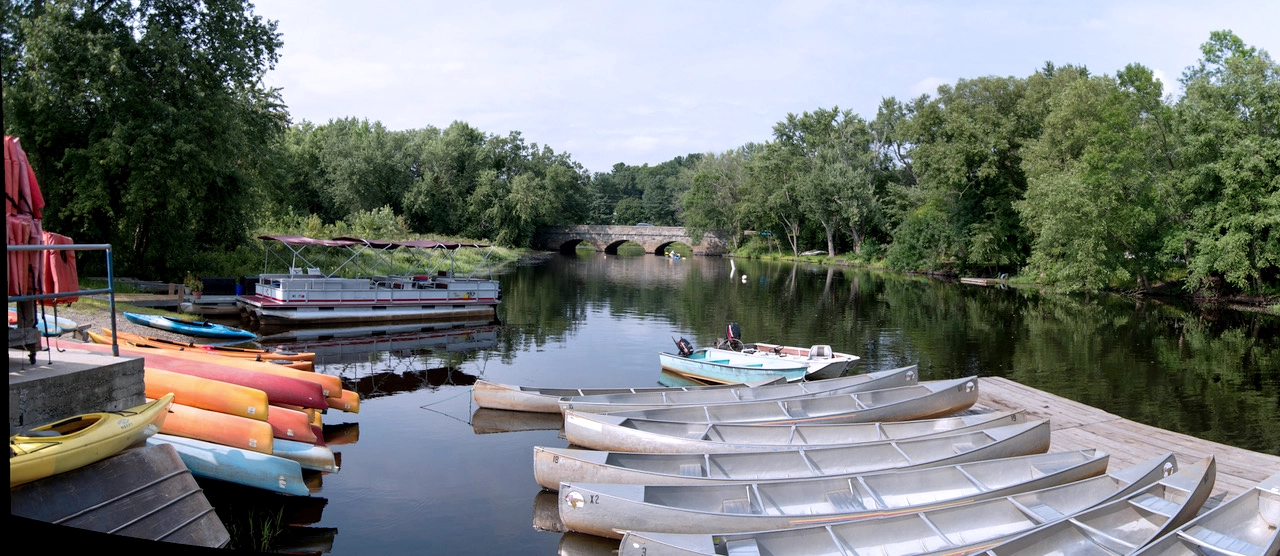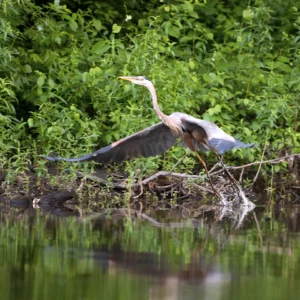A Story of Wildlife, Beauty, and Peace on the Water
July 11, 2022
Published month 2022

As I pull into the parking area in early summer, I see people down at the dock of the quaint wooden boathouse on the Sudbury River. Family-owned South Bridge Boat House on Route 62 in Concord is the gateway to the rivers for all who would like to rent a kayak or canoe to explore. You can even walk there from the Concord commuter rail station. I say rivers because you can reach all three Wild & Scenic Rivers—the Sudbury, Assabet, and Concord Rivers—from the spot! If you have your own boat, an interactive river map from the watershed organization OARS shows where you can put in. Visit our River Maps page to find our online land downloadable recreation maps.
Today, we push off downstream, paddling down the Sudbury River to where it meets the Assabet River at Egg Rock. This trip is special for me because, in 2005, I took my family for a spring picnic paddle here for the first time. A few weeks later, I spied a job advertisement at OARS and have worked there ever since! I am fortunate to work on science-based advocacy, river recreation, and education every day.

We paddle northward to where the Sudbury and Assabet rivers meet to create the Concord River, which flows north to Lowell to join the Merrimack River. The water under our boat has already traveled up to 30 miles from Westborough and will travel a further 50 miles to the Atlantic Ocean at Newburyport. Our first wildlife sighting is a group of painted turtles lined up head-to-tail on a floating log in the sun.
The Assabet River gets its name from the Algonquin word referring to the reeds along the banks. The Native American name for this stretch of the Sudbury and Concord rivers was Musketaquid, which roughly translates to “grassy knoll.” This riverine great meadow stretched over 20 miles and supported early farming towns. The rivers were well known for the plentiful fish, especially river herring and shad, that migrated up from the ocean. The rivers were dammed starting in the early Industrial Revolution, which ended the annual fish migration. The 29 miles of federally designated “Wild & Scenic Rivers” contain no dams and are protected for their outstanding values.
As we get to Egg Rock at the confluence of the Sudbury and Assabet, we pull up near the left back to read the 1885 inscription commemorating the founding of Concord in 1635:
On the hill Nashawtuck
at the meeting of the rivers
and along the banks
lived the Indian owners of Muxketaquid
before the white men came

En route, we surprised a great blue heron—it led us down the river, staying just ahead. If you’re lucky, you can see muskrat, beaver, or even bald eagles.
After Egg Rock, we take a left and paddle a short way up the shallower Assabet to the unusual “leaning hemlocks” on the left bank. We search out the stone at their roots engraved with a fragment of a poem by George Barlett (1832–1896).
Then we head back downstream to the Concord River and go a short distance to the old North Bridge at Minute Man National Historical Park. On April 19, 1775, with the local minutemen on one side of the river and the British redcoats on the other, the “hot heard ’round the world” was fired right here. The view from the river gives you a sense of scale that is quite different from what you can see on land.
Later, this place was the backdrop to a quieter revolution—one of philosophy and spirituality. Ralph Waldo Emerson’s essay “Nature” in 1836 plowed fertile ground for the Trancesndentailst movement. It included local authors Amon Bronson Alcott, William Ellery Channing, and Henry David Thoreau and attracted other well-known writers such as Margaret Filler, Henry Wadsworth Longfellow, Frederic Henry Hedge, Theodore Parker, and Walt Whitman. They shared a new vision of society, inspired in part by nature. Many spent countless hours exploring the rivers.
We disembark to stretch our legs and tour the fascinating Old Manse and Robbins House. Our hearts and minds are full of history and nature; we make the journey back upriver to return our boats and head home.
“Rowing our boat against the current, between wide meadows, we turn aside into the Assabeth. A more lovely stream than this, for a mile above its junction with the Concord, has never flowed on earth— nowhere, indeed, except to lave the interior of a poet’s imagination.”—Mosses from and Old Manse by Nathaniel Hawthorn, 1854
From South Bridge Boat House to North Bridge is a 2.8-mile round trip, plus the short detour up the Assabet. Concord’s rivers have something for everyone, and it is a remarkable feeling to know that you have traveled this ancient and beautiful highway and never even seen a road.
What you can do for our rivers
- Enjoy and be an advocate for the rivers
- Leave no trace and pick up trash
- Be a citizen scientistWater Monitoring Citizen Scientist and collect water quality data
- Be a Aqua Avenger and lean how to pull our invasive water chestnut
- Become a member of OARS
Published in

